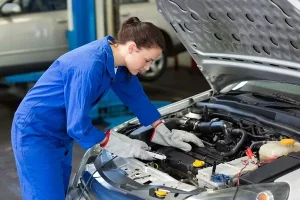Navigating the World of Autonomous Vehicle Maintenance

Think of the day when your automobile identifies its own service needs by entering a computer, scheduling an appointment and, using the vehicle-to-infrastructure (V2I) communication system, driving itself to the repair facility – that day might not be too far off. This is just one of the many potential advantages offered by autonomous vehicles, or AVs, which some industry analysts refer to as the ‘fifth disruption’.
Dependent on a number of computerised sensors and cameras to sense their surroundings, Autonomous Vehicles are vulnerable in ways that are particularly sensitive to meteorological environments. You’ve likely struggled to see through the glare of the sun in the driving seat of a car when it’s low in the sky, or been taken aback by a sudden error in the car’s adaptive cruise control as you circle through a precipitation cloud.
AVs Bring New Challenges to the Service Environment
Autonomous vehicles would involve a massive conversion to the service economy and a need for specialised types of labour to maintain them, especially in the case of ride-sharing services where AVs may be hundreds of miles removed from maintenance garages.
Many automotive and tech companies have been developing vehicles with level 3 automation or higher, and transportation network companies such as Lyft have begun running fleet AV shuttle services on public streets.
AVs could ease traffic congestion, mitigate environmental and social problems facing urban transit, and help solve major logistical challenges. But there are hurdles that lie ahead for this technology. A human truck driver will probably be quick to spot performance problems with his vehicle, but autonomous vehicles might take far longer to report them. And what about driving ‘conditions’? We don’t yet know how AVs will operate in different situations.
AI-Powered Inspections
His AI-enabled visual inspection system automates, simplifies and standardises inspection flowlines, allowing organisations to deliver higher-quality goods at a lower cost, simultaneously improving operational efficiency.
Using new computer vision algorithms, these systems can ‘see’ and interpret the data it receives from cameras or sensors that attaches onto inspection devices like vehicles to detect defects, shapes and damages without any human work now possible. Technology can now enforce higher standards by salvaging more materials, while dramatically reducing turnaround times.
Visual inspection systems can have AVs equipped with these systems scan vehicles at 5 mph and identify and, within seconds, categorise damage. Take, for example, hidden sidewall tears from slit smears, as well as debris and nails entering the tire. It’s very easy for these problem areas to go unnoticed when inspected by hand. By quickly spotting these issues, DSPs can put a vehicle on the road faster for a customer, thereby reducing delivery downtime.
Automated Vehicle Checkpoints
Checkpoints need human oversight; but technology can help with the efficiency and effectiveness of gate searches at points of entry (POE), airports and other checkpoint locations.
Geospatial technology offers precision border security and monitoring by drawing on data from satellite images, cartographic maps and IoT (internet of things) sensors at checkpoints, and comparing to loads at that time and place in the past, and relative to cargo trucks, buses or cars in different such situations; and with AI (artificial intelligence)-powered efficiencies, optimising the deployment of Internet of Things sensors for maximum effect.
Nirovision’s solution is an AI checkpoint using IP cameras to capture vehicle licence plates, conduct driver ID and compliance checks, and give the green light to enter or not. When combined with access control systems this automatically streamlines the process without guards or physical swipe cards – improved processes, significant cost savings and elimination of employee transgressions before they occur due to lack of knowledge or compliance.
AI-Based Diagnostics
Modern AI systems use large amounts of data gathered by sensors, telematics devices and other such devices to make predictions, identify patterns and optimise fleet operations. For instance, neural networks in AI systems can detect unsafe driving behaviour (eg, aggressive acceleration and braking) and warn drivers about maintenance needs (eg, warnings about low tyre pressure, engine failures, etc).
Others are focusing on the interior of a car; Audi, for example, is currently using AI in its production lines to improve efficiency and measurement, to, for one, ensure that robots are correctly installing components in vehicles before they are shipped to dealers. One form of AI is called computer vision AI. This focuses on images or video feeds, but can show far greater accuracy and attention to detail than a human engineer. One application using computer vision AI in the car industry is to pinpoint micrometre-scale cracks in sheetmetal vehicles as they are produced, allowing defects to be identified before vehicles are driven off the factory floor.
For instance, ML algorithms can make predictions based on real-time data and alert you when scheduled maintenance is required. Furthermore, smart systems such as these recommend maintenance activities in alignment with the specific characteristics of your vehicle and your vehicle service history. This predictive approach also helps in reducing costs while improving the performance and reliability of vehicles.







